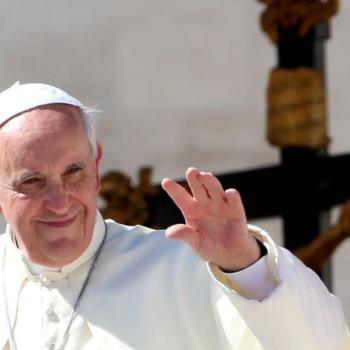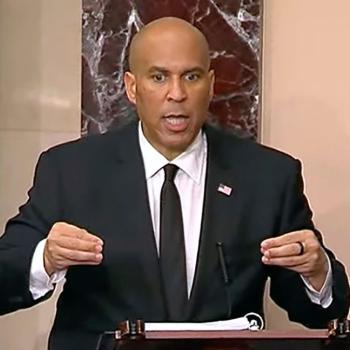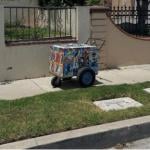On Palm Sunday, thousands of churches will use sustainably-harvested palms in their worship services marking the beginning of Holy Week. It is right and good that more congregations are recognizing the need to exercise environmental responsibility when it comes to liturgical practices. Organizations such as Eco-Palms protect important forests and sustainable livelihoods in the harvesting communities. But let’s not end there. The sermon, too, can incorporate ecojustice themes that highlight the connection between Jesus’ crucifixion and the eco-crucifixion happening today.

We begin our Palm Sunday services with our palm fronds and branches lifted high, singing “All Glory, Laud and Honor.”
Our voices echo those of the crowds gathered outside of Jerusalem waving branches, spreading their cloaks on the road. They were cheering on the man they hoped would lead them to a glorious military victory over the Roman Empire.
Less than thirty minutes later, we’re all yelling, “Crucify him!” when the dramatic reading of the Passion story calls for us to call out these words.
What happened? Why the sudden 180-degree turn? As soon as the crowds in Jerusalem realized that Jesus is a leader of sacrificial peace instead of bloody war, they turn on him. One minute their chanting, “Hosanna to the Son of David!” Soon after that they’re screaming, “Crucify him!”
For some people this sudden move from Palms to Passion is jolting.
We feel uncomfortable calling for Jesus’ death. We don’t want to be identified with that crowd. Some Christians and certain churches even avoid the entire Holy Week journey altogether. They have Palm Sunday, alright. But they skip over all the dark, ugly, graphic parts of the story on Good Friday. They go right from palms to Easter lilies. None of that messy stuff in between.
Lutherans, drawing on Dietrich Bonhoeffer, call this “cheap grace.”
Because it requires no change, no response. It provides no means for a change of heart, for a transformed attitude, for a moment of self-awareness, repentance and a decision to lead a life of reconciliation.
But we choose not to ignore the suffering of Jesus. We believe it is vital that we tell all parts of the story, and that we recognize ourselves as part of both crowds – the ones who cheer, and the ones who call for crucifixion. Especially as our planet is undergoing an eco-crucifixion, it is imperative that we tell that part of the story as well. The crucifixion of Jesus happened once in history. But the crucifixion of Earth is carried out daily.
Crucified Earth

Mark I. Wallace, in his book Finding God in the Singing River: Christianity, Spirit, Nature (Philadelphia: Fortress, 2005), offers a novel image of Earth as the continually crucified Spirit of God. By seeing the Holy Spirit as the feminine aspect of God, which then becomes embodied in the natural world, he builds on Sallie McFague’s notion of Earth as God’s body. He then shifts the focus to the third person of the Trinity and incorporates the Divine Feminine. He makes the connection to Christ’s crucifixion in this way:
If God’s body – this small planet that is now under siege by continued global warming, deforestation, the spread of toxins, the chronic loss of habitat – continues to suffer and bleed, then does not God, in some sense real but still unknowable and mysterious to us, also suffer and bleed? . . .
If it is the case that when the earth, God’s body, suffers, then God’s Spirit suffers as well, then we can say that the Spirit of God is ‘Christ-like’ or ‘cruciform’ because the Spirit suffers the same violent fate as did Jesus – but now a suffering not confined to a onetime event of the cross, as in the case of Jesus, but a suffering that the Spirit experiences daily through the continual debasement of the earth and its inhabitants . . . [T]he Spirit bears the cross of a planet under siege as she lives under the burden of humankind’s ecological sin (Wallace, 23 – 24).
Wallace warns of a “permanent trauma to the divine life itself” (Wallace, 129).
This trauma happens through the crucifixion-like ecocide that humans continually inflict upon Earth and its inhabitants). His powerful equation of God’s suffering through Jesus on the cross with God’s suffering through the embodied Spirit in Earth is meant to spurn “a conversion of the heart to a vision of a green earth, where all persons live in harmony with their natural environments” that persuades us “to work toward a seamless social-environmental ethic of justice and love toward all of God’s creatures” (Wallace, 136).
So on Palm Sunday, we tell the story of the Passion to remember.
We tell this story to our children so that they remember. Lest we think ourselves so much more advanced than those who attacked Jesus, we must recognize that we are no different today. What was done to Jesus is still done to people and our planet.

Native Americans continue to lose their sacred land sacrificed to the colonization of the oil and gas industry. Communities of color continue to be targeted for polluting industries and toxic landfills. Island nations such as Puerto Rico are raked by catastrophic storms super-charged by climate change and given little help in recovery. Coral reefs worldwide are bleaching and dying. Billions of populations of plants, fish, and animals have been lost in recent decades in what scientists are calling a “biological annihilation.”
We are in the midst of the sixth mass extinction event since life began on this planet.
So, yes, the crucifixion of our planet and people is real and ongoing.
There is a hymn sometimes sung during Holy Week entitled, “Ah, Holy Jesus” (Johann Heermann, 1630).
Ah, Holy Jesus . . .
Who was the guilty? Who brought this upon thee?
Alas, my treason, Jesus, hath undone thee.
Twas I, Lord Jesus, I it was denied thee.
I crucified thee.
On Palm Sunday and Holy Week, we consciously and intentionally remember that we are guilty and have committed eco-crucifixion against people and planet.
The pain of eco-crucifixion is real, and that the voices of those who suffer need to be heard. We must speak of this in our worship service so that we do not become numb to the pain and thus apathetic towards our sisters and brothers. Because if we cut ourselves off from their pain, the cycle of violence will only continue.
But there is another reason why we tell this story.
We do this to remember what God is doing in response to this crucifixion. Some might say, “Well, yes, God sent Jesus to die for our sins. God allowed Jesus to die in order to make payment for our sins. That’s what God is doing here, right?”

However, I would again argue that this is also “cheap grace.” Because this theory of atonement requires no response from us. It provides for no change of heart, or a transformed attitude, or a moment of self-awareness, repentance and a decision to lead a life of reconciliation.
Does God really require the killing of Jesus in order to be satisfied for our sins? No. But humans do.
The domination systems had to kill Jesus because he was a threat to their power. And we continue to sacrifice lives for the sake of institutional domination, imperial arrogance, economic and territorial greed, and petty pride.
But God answers all of this in the crucifixion and resurrection of Jesus. The answer is: this must stop!
If God wanted sacrifice, then Jesus would have remained dead. That’s not what happened. Jesus was resurrected. Jesus lives. This means that God does not condone violence committed against God’s Creation. God submits to it, absorbs it, and lives right through it in order to be in solidarity with those who suffer through it. And then God resurrects the condemned one, the betrayed one, the crucified one in order to show that this act of violence is not the last word.
I have to believe that God, who has brought us through 14 billion years of time, will not abandon us now.
That somehow God is working through even this human-made catastrophe of global climate change, deforestation, massive extinction, and toxic poisoning to find a way for life to push through once again. So I make the choice to believe – and act on my firm belief – that on the other side of the Good Friday of the eco-crucifixion, there is an eco-resurrection. [I discuss eco-crucifixion and eco-resurrection Creation-Crisis Preaching: Ecology, Theology, and the Pulpit in my book (Chalice Press, 2015).]
Stay with the journey to the cross.
Don’t turn away from it. It will not be easy. But this is part of God’s plan to transform the worst of humanity into the very best that God intends for God’s people, for our planet, and for our future.
This reflection is also available at the Lutherans Restoring Creation website, which has ecotheological reflections for every Sunday of the three-year lectionary cycle. Check out the LRC sermon reflection archive here.

Leah D. Schade is the Assistant Professor of Preaching and Worship at Lexington Theological Seminary (Kentucky) and author of the book Creation-Crisis Preaching: Ecology, Theology, and the Pulpit (Chalice Press, 2015). She is an ordained minister in the Lutheran Church (ELCA).
Twitter: @LeahSchade
Facebook: https://www.facebook.com/LeahDSchade/.
Read also:
Is Earth Worth Dying For? A Reflection on the Earth Martyrs
Six Children’s Sermon Ideas for Earth Day
No, Mr. Pruitt, Fossil Fuels Are Not God’s ‘Blessing’ for Humanity













